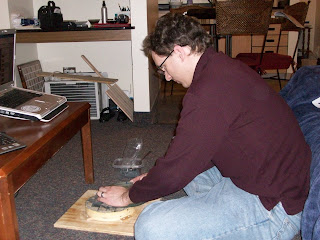
Now that we've gotten our target depths, we need to work down through the grits making a finer and finer surface until the glass is polished. Each grit needs about 45 minutes to an hour of grinding to get the job done. To ensure that the mirror is ready for the next grit, the surface is inspected with a jeweler's loupe. If the surface is more-or-less uniformly rough, then it is ready. If there is an occasional large pit, then it is likely a feature caused by the previous grit and not yet ground out. Each grit brings the surface to a uniform roughness much smoother than the last, until we are ready to polish the glass to optical quality.
Twice now I've worked my way through two grits of silicon carbide (120/220 and 240), and two grits of aluminum oxide (25 and 12 microns), only to find a large scratch on an otherwise smooth surface. These scratches are definitely appearing some time during the 12 micron fine grinding because they are large enough that they should have been noticeable even at quite rough grinding. I have had to go back to the 120/220 grit silicon carbide just to grind the scratches out! You can see the scratch after my second go-around running across the middle of the mirror in this picture. Under the loupe it looks absolutely like a great canyon through otherwise gentle terrain.
Some consequences to this back-and-forth are:
1. I've decided to do a focal ratio of 5.5, just because it should be easier to figure and I'm getting impatient to see the mirror aluminized.
2. Cam has caught up with me on her 6 inch mirror, and now we're working together with the same grit (25 micron aluminum oxide for our next session).
3. I no longer trust grinding with the tool on top. I suspect that coarse grit has dislodged from some nook or cranny in my tile tool and fallen onto the glass surface to create these scratches. By working with mirror on top from now on, hopefully any hidden grains will remain in their hiding spot and I won't get any more scratches.


















